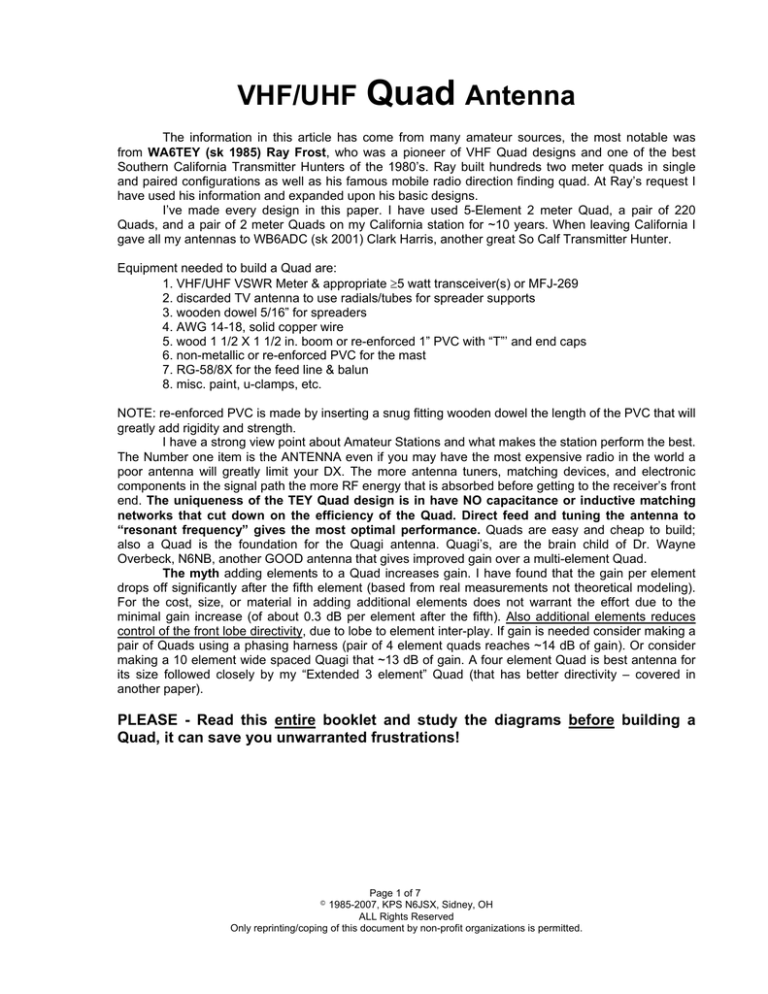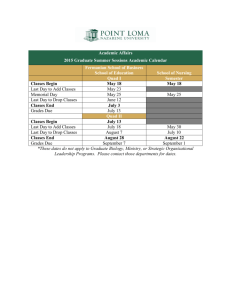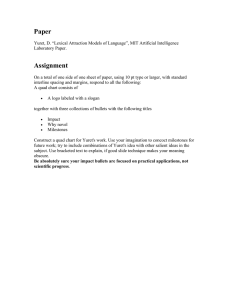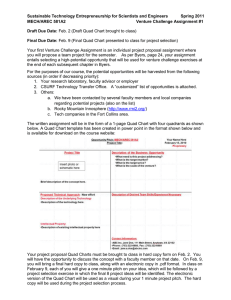
VHF/UHF
Quad Antenna
The information in this article has come from many amateur sources, the most notable was
from WA6TEY (sk 1985) Ray Frost, who was a pioneer of VHF Quad designs and one of the best
Southern California Transmitter Hunters of the 1980’s. Ray built hundreds two meter quads in single
and paired configurations as well as his famous mobile radio direction finding quad. At Ray’s request I
have used his information and expanded upon his basic designs.
I’ve made every design in this paper. I have used 5-Element 2 meter Quad, a pair of 220
Quads, and a pair of 2 meter Quads on my California station for ~10 years. When leaving California I
gave all my antennas to WB6ADC (sk 2001) Clark Harris, another great So Calf Transmitter Hunter.
Equipment needed to build a Quad are:
1. VHF/UHF VSWR Meter & appropriate ≥5 watt transceiver(s) or MFJ-269
2. discarded TV antenna to use radials/tubes for spreader supports
3. wooden dowel 5/16” for spreaders
4. AWG 14-18, solid copper wire
5. wood 1 1/2 X 1 1/2 in. boom or re-enforced 1” PVC with “T”’ and end caps
6. non-metallic or re-enforced PVC for the mast
7. RG-58/8X for the feed line & balun
8. misc. paint, u-clamps, etc.
NOTE: re-enforced PVC is made by inserting a snug fitting wooden dowel the length of the PVC that will
greatly add rigidity and strength.
I have a strong view point about Amateur Stations and what makes the station perform the best.
The Number one item is the ANTENNA even if you may have the most expensive radio in the world a
poor antenna will greatly limit your DX. The more antenna tuners, matching devices, and electronic
components in the signal path the more RF energy that is absorbed before getting to the receiver’s front
end. The uniqueness of the TEY Quad design is in have NO capacitance or inductive matching
networks that cut down on the efficiency of the Quad. Direct feed and tuning the antenna to
“resonant frequency” gives the most optimal performance. Quads are easy and cheap to build;
also a Quad is the foundation for the Quagi antenna. Quagi’s, are the brain child of Dr. Wayne
Overbeck, N6NB, another GOOD antenna that gives improved gain over a multi-element Quad.
The myth adding elements to a Quad increases gain. I have found that the gain per element
drops off significantly after the fifth element (based from real measurements not theoretical modeling).
For the cost, size, or material in adding additional elements does not warrant the effort due to the
minimal gain increase (of about 0.3 dB per element after the fifth). Also additional elements reduces
control of the front lobe directivity, due to lobe to element inter-play. If gain is needed consider making a
pair of Quads using a phasing harness (pair of 4 element quads reaches ~14 dB of gain). Or consider
making a 10 element wide spaced Quagi that ~13 dB of gain. A four element Quad is best antenna for
its size followed closely by my “Extended 3 element” Quad (that has better directivity – covered in
another paper).
PLEASE - Read this entire booklet and study the diagrams before building a
Quad, it can save you unwarranted frustrations!
Page 1 of 7
© 1985-2007, KPS N6JSX, Sidney, OH
ALL Rights Reserved
Only reprinting/coping of this document by non-profit organizations is permitted.
Quad Dimension Formulas
Element
Reflector
Driver
Director 1
Director x
Formula
1030 / F (in MHz)
1005 / F (in MHz)
975 / F (in MHz)
920 / F (in MHz)
Data
= A’
= B’
= C’
= D’
Circumference of Quad wire loop is ((A or B or C or D) * 0.97(VF)) *12 (inches) = Zt
Distance from center of the boom to wire support on spreader is (1.414213 * (Z/4)) / 2 = Y
Z = Zt / 4
Velocity Factor = 0.97 (for solid 14-20 gauge copper wire).
A = metal tubing (TV aerial radials) 3/8" O.D. about 14-20” long)
B = Wood doweling 5/16" - insulated spreaders
C = boom
Element wire - #18 solid enameled - strip ends before soldering
Elements
Z
Basic Quad Dimensions
Y
Zt
Spacing Bazooka
.
146.000 MHz.
reflector
driver
director 1
director x
20.5
20
19.4
18.3
14.5
14
13.75
13
82
80
77.6
73.2
12
10
9.0
9.0
224.000 MHz.
reflector
driver
director 1
director x
13.4
13.1
12.7
12.0
9.5
9.23
9.0
8.5
53.5
52.2
50.7
47.8
7.7
6.5
6.1
6.1
446.000 MHz.
reflector
driver
director 1
director x
6.7
6.6
6.4
6.0
4.7
4.7
4.5
4.2
26.9
26.2
25.5
24.0
3.9
3.3
3.1
3.1
13.25
8.7
4.3
Page 2 of 7
© 1985-2007, KPS N6JSX, Sidney, OH
ALL Rights Reserved
Only reprinting/coping of this document by non-profit organizations is permitted.
How to build a QUAD (in brief)
These brief statements are to supplement the illustrations & diagrams.
1. Tune up should be conducted with as little surrounding metal as possible and with the quad pointing
away from any near structures. Study all illustrations before proceeding.
2. Make the Bazooka Balun. Firmly tape the coax to the spreader, boom, and mast. The feed point is on
the horizontal spreader for vertical polarization.
3. Before tuning install all metal spreader supports, metal mast, and metal hardware that you are going
to use. (This allows you to tune/compensate for any antenna RF pattern anomalies generated by metal
in the near filed radiation area.)
4. Construct the Reflector and Driver - first - add about 8 inches of wire to the Zt dimensions.
Make the isolation spreader for the Driven element - see Quad Feed Point diagram.
Place all the spreaders into the Reflector and Driven element holding tubes - measure a place
all the spreaders at the proper dimensions.
NOTE: I use electrical tape or lightly crimp the metal tube at the metal tube to wooden dowel
intersecting point to hold the dimension.
Adjust the driver feed points by increasing or decreasing the Reflector overall wire length. This
allows you to obtain the lowest VSWR reading at the designed frequency.
HINT: Adjust the Driver for the best VSWR and then trim with the Reflector circumference dimension...
then back to the Driver and to re-trim...etc.
Expected nominal results: ONLY Reflector & Driver
3 el Quad
3 el VSWR
3 el Quad
3 el VSWR
144.100
1.7:1
221.000
1.7:1
145.000
1.4:1
222.000
1.4:1
145.500
1:1
222.500
1:1
146.000
1:1
223.000
1:1
146.500
1:1
223.500
1:1
147.000
1:1
224.000
1:1
147.995
1:1
224.980
1:1
5. Install and solder the Director(s) to their specified dimensions. Measure and make the Director(s) a
perfect diamond.
HINT: Make the wire the Zt dimension and permanently solder the wire - then pull the spreaders out to
make a tight diamond with no wire sag! Pin the dowels into the metal tubes will keep the shape for a
long time.
Note: VSWR will probably go up; so go back to step 4 and re-tune the Driver and Reflector to obtain the
best VSWR.
6. When VSWR is relatively low or as you desire solder and fasten down the Reflector. Recheck the
VSWR and trim the Driver as necessary. Then solder and fasten down the Driver.
Page 3 of 7
© 1985-2007, KPS N6JSX, Sidney, OH
ALL Rights Reserved
Only reprinting/coping of this document by non-profit organizations is permitted.
4 el Quad
144.100
145.000
145.500
146.000
146.500
147.000
147.995
Nominal results: full Quad all elements
4 el VSWR
4 el Quad 4 el VSWR
2.3:1
221.000
2.3:1
1.4:1
222.000
1.4:1
1:1
222.500
1:1
1:1
223.000
1:1
1:1
223.500
1:1
1:1
224.000
1:1
1.2:1
224.980
1:1
7. If you have a field strength meter or BETTER a distant visual repeater, adjust the invisible front main
lobe for directivity. This is accomplished by moving the Driven element horizontal spreaders left or right
to obtain maximum indication on the field strength or "S" meter while sighting down the vertical
spreaders at the repeater antenna.
NOTE: Your body being near the antenna can skew the radiated pattern. So move a few feet away from
the antenna when making measurements.
8. Measure, align, and set all spreader elements for a good diamond shape.
9. The antenna is built; now preserve the antenna in any fashion you deem necessary for your weather
environment.
Recommendations: silicon caulk the coax on the driver feed connections, marine spar varnish over a
coat of paint, peg the spreader wooden dowels if desired to increase stability.
NOTE: the more metal on the spreaders the less dowel to treat. In Southern California the heat/
wind/rain/smog weather antennas quickly.
Page 4 of 7
© 1985-2007, KPS N6JSX, Sidney, OH
ALL Rights Reserved
Only reprinting/coping of this document by non-profit organizations is permitted.
The BAZOOKA BALUN is the Secret for maximum efficiency of these Quads! The bazooka
balun is the only "Matching" device used. The bazooka balun is effectively an RF choke used to kill
all/any returning RF energy from being conducted on the coax shield. The bazooka is the means of
connecting an unbalanced (coax) line to a balanced antenna.
The Bazooka Balun eliminates extraneous capacitive or inductive matching networks. This
allows the Quad to be tuned to resonant frequency for maximum signal reception. As shown in the
Quad Feed Point illustration the coax is soldered directly to the antenna driven element. This highly
efficient coupling method conducts the most received RF signal into the receiver. Many of today’s
antennas use the easy to make/tune loss’ee capacitive/inductive gamma type matches which consume
some amount of antenna RF energy, thus, taking received signal from the radio RF amp/1st mixer!
Page 5 of 7
© 1985-2007, KPS N6JSX, Sidney, OH
ALL Rights Reserved
Only reprinting/coping of this document by non-profit organizations is permitted.
Page 6 of 7
© 1985-2007, KPS N6JSX, Sidney, OH
ALL Rights Reserved
Only reprinting/coping of this document by non-profit organizations is permitted.
Pair of Quads - Phasing Harness
(approximately 14 dB gain)
Each leg of coax from the antenna to the first barrel connector is of RG-58 coax with bazooka balun at a
length of 66.25 inches each (each leg must be identical) and attached as shown for both antennas to be
“IN” phase complementing one another.
The phasing harness is of RG-59 coax (72 ohm) at 15 inches long.
A minimum of 72” of horizontal spacing should be placed between two vertically polarized Quads
______________________________________________________________________________
References:
WA6TEY VHF Quad design
73 VHF Antenna Handbook
RSGB VHF-UHF Manual
______________________________________________________________________________
Page 7 of 7
© 1985-2007, KPS N6JSX, Sidney, OH
ALL Rights Reserved
Only reprinting/coping of this document by non-profit organizations is permitted.




